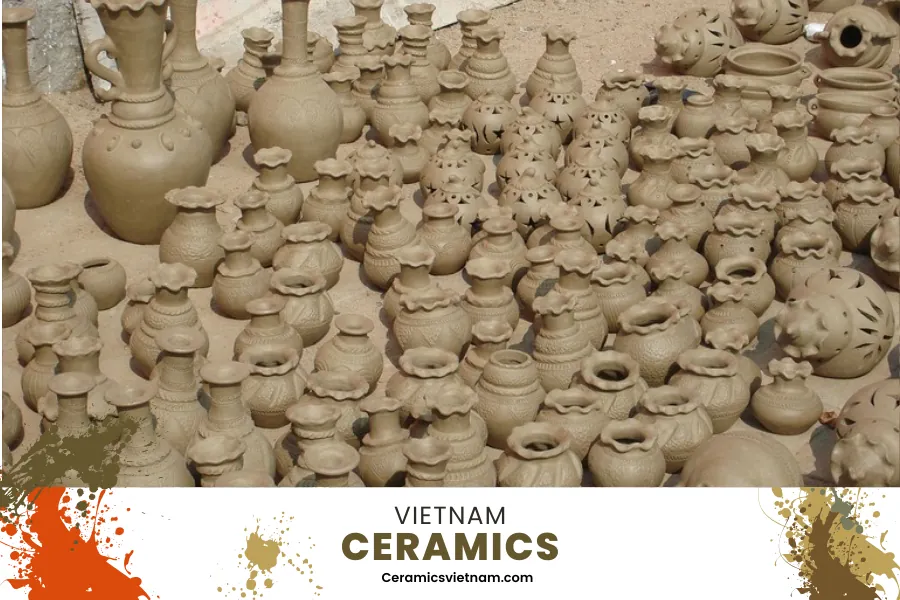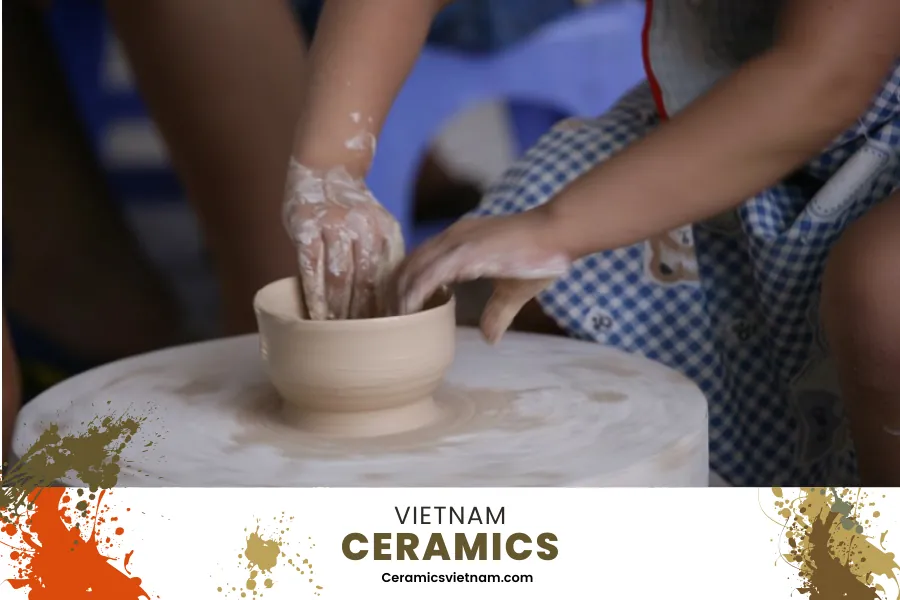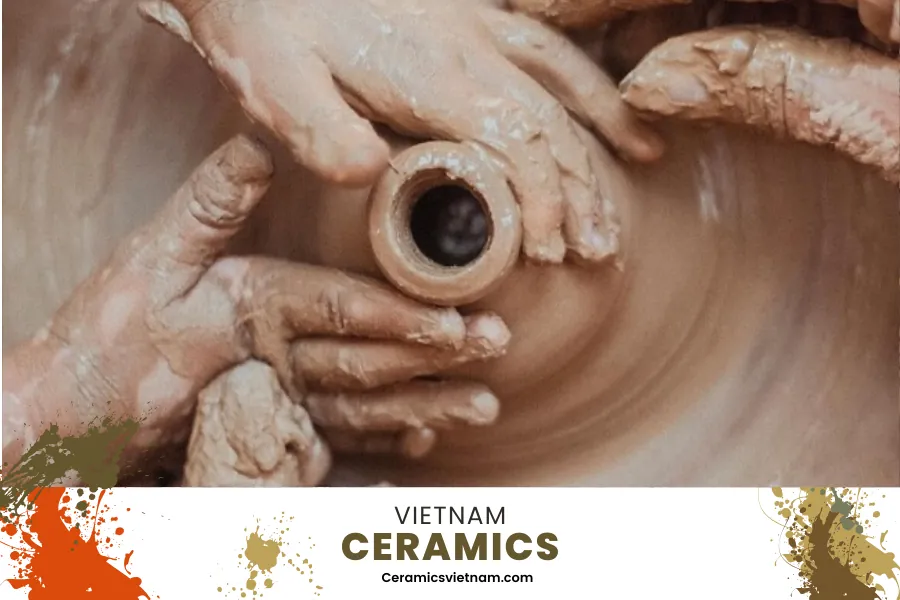Since its inception, Ceramics has always been one of the most beloved decorative art products for Vietnamese people. However, creating these exquisite pieces requires a harmonious blend of functionality and artistry, between earth, water, and the skilled hands of artisans. Let’s explore the ceramics making process together with CeramicsVietNam – 5 steps to produce the finest quality ceramic products.
Vietnamese ceramics

5 steps in the ceramics making process you need to know
Vietnamese ceramics hold a rich and vibrant heritage deeply rooted in the country’s cultural identity. Renowned for their exquisite craftsmanship and artistic expression, Vietnamese ceramics have been treasured both locally and internationally for centuries.
The history of Vietnamese ceramics dates back to ancient times, with evidence of pottery production found in archaeological sites throughout the country. From utilitarian vessels to intricate decorative pieces, ceramics have played a significant role in Vietnamese daily life, rituals, and trade.
Vietnamese ceramics are characterized by their diverse range of styles, techniques, and motifs, reflecting the country’s complex cultural influences and regional variations. Traditional pottery villages such as Bat Trang, Phu Lang, and Chu Dau have preserved age-old crafting methods passed down through generations, each contributing unique characteristics to the art form.
One of the distinctive features of Vietnamese ceramics is the harmonious blend of functionality and aesthetics. Artisans skillfully marry utilitarian purposes with artistic expression, creating pieces that are not only beautiful but also practical for everyday use.
The decorative motifs found in Vietnamese ceramics often draw inspiration from nature, mythology, and folklore. Intricate patterns of lotus flowers, dragons, phoenixes, and other symbolic motifs adorn many ceramic pieces, symbolizing prosperity, longevity, and good fortune.
In addition to traditional techniques, contemporary Vietnamese ceramic artists continue to innovate and experiment, pushing the boundaries of the art form. Modern ceramicists incorporate new materials, technologies, and design concepts while preserving the essence of traditional craftsmanship.
Vietnamese ceramics have gained international recognition for their exceptional quality and artistic merit. They are sought after by collectors, art enthusiasts, and connoisseurs worldwide, contributing to Vietnam’s cultural heritage and artistic legacy on the global stage.
From humble pottery workshops to prestigious art galleries, Vietnamese ceramics continue to captivate audiences with their beauty, diversity, and timeless appeal, showcasing the country’s rich artistic heritage and enduring creativity.
Understanding the traditional handcrafted Ceramics making process

5 steps in the ceramics making process you need to know
The ceramics making process consists of 5 main steps, including: Clay processing; Glazing; Decoration; Firing; and Glaze firing. This is the general process of creating quality ceramic products by artisans. However, each stage of the ceramic making process is performed differently depending on the skill level of the craftsmen.
Step 1: Clay Processing – Selecting and Processing Clay The first step in the ceramics making process is to select the best raw materials, which are clay and kaolin. Then, the clay will undergo various stages of refinement to obtain the best clay for making ceramics.
Clay, when mined, is usually very hard and needs to go through a refinement process, including watering and thin slicing. Then, impurities are removed, and the clay is kneaded thoroughly before being formed into large piles. This clay will be kneaded repeatedly to achieve smoothness and plasticity. This initial stage is called clay processing.
Step 2: Glazing – Shaping Ceramic There are 3 main methods for shaping ceramics: shaping ceramics on a potter’s wheel; shaping ceramics with molds; and hand molding ceramics. Some products are created by combining all three methods. The specific methods are as follows:
- Potter’s Wheel Shaping With this method, the clay needs to be kneaded to a pliable consistency. Then, the clay is molded into long strands using the wrists, and the artisan cuts and shapes them on the potter’s wheel. Both hands are used, and sometimes the artisan uses their feet to control the wheel’s rotation. Products of various sizes and shapes are controlled solely by the artisan’s hands. This method is often used to produce large-sized ceramic products such as pots, jars, and bowls.
- Mold Shaping Mold shaping is often used to produce large-sized products such as plates, dishes, and bowls.
- Hand Molding Hand molding techniques are commonly used for small details such as handles, spouts, lids, vases, and various animal and figurine designs.
Step 3: Decorating Ceramics The decoration process is crucial for the aesthetic appeal and value of ceramic products. After shaping and drying, artisans use brushes to paint and create patterns, enhancing the artistic value of each product. Ceramics are decorated using the following methods:
- Direct Painting Artisans often use brushes to paint directly onto the surface of ceramics with desired patterns and motifs. This process requires extensive experience and highly skilled hands. Each hand-painted ceramic product becomes a unique piece of art. Additionally, artisans may use methods such as painting with colored glazes, sgraffito, or applying flowing glazes to create distinctive products. Patterns can be painted either before or after glazing.
- Recently, aside from direct painting, artisans also use techniques such as painting on the bone china surface after undergoing a preliminary firing or transferring pre-printed designs onto ceramics using decals imported from abroad (commonly from China). However, this method is not considered a creative art form in traditional Vietnamese ceramics but rather a decorative technique.
- Carving and Incising Ceramic Products After shaping, products are air-dried under sunlight. Once hardened, artisans trim and smooth the surfaces according to the desired shapes. Details such as ears, handles, leaf and flower patterns, and raised animals are carved out. Carving is the primary method used by craftsmen before glazing and firing ceramics.
- Pattern Printing with Molds After forming the ceramic body, instead of painting or carving directly onto the surface, artisans use a mold with engraved patterns to press onto the ceramic body. The final step is glazing before firing. The thickness of the glaze layer creates an effect, revealing the pre-made patterns. Common products using this method include brown-glazed ceramics and celadon ceramics.
Step 4: Glazing After the decoration stage, ceramic products undergo a preliminary firing, followed by applying a layer of glaze before the final firing. Depending on the type, some products do not go through the preliminary firing. Small-sized products are usually dipped into glaze, while larger ones are brushed or sprayed.
- Glaze Touch-ups Artisans further adjust the products before placing them in the kiln. They carefully inspect each product for any missing glaze and apply it meticulously, followed by fine-tuning. This process is known as glaze touch-ups.
Step 5: Firing Ceramic Products This is a crucial stage that determines the success or failure of a batch of ceramics. Various types of kilns are used for firing ceramics, with the most common ones being coal kilns and gas kilns, with box kilns gaining popularity recently.
- The firing process for ceramic products The kilns are fueled by wood, sawdust, or gas. The firing time and temperature vary depending on the kiln type and specific ceramic type. Specifically: Earthenware is fired at temperatures ranging from 600 to 900°C; brown-glazed ceramics from 1100 to 1200°C; celadon ceramics from 1200 to 1250°C; white-glazed ceramics from 1250 to 1280°C; and porcelain from 1280 to 1350°C. All products of Long Phuong ceramics undergo double firing at the highest temperature of 1380°C to achieve white, glossy glaze and the finest level of sophistication.














Leave a reply